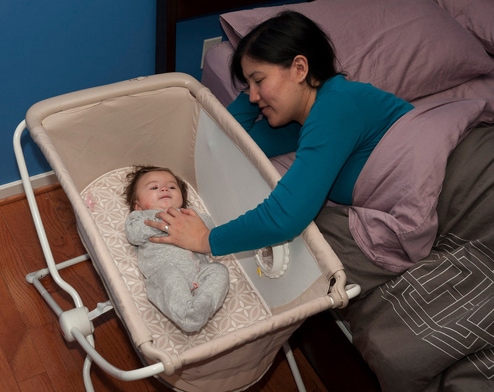Sudden Infant Death Syndrome (SIDS) is the sudden, unexplained death of a baby younger than one year old. You’ll both sleep easier if you know how best to keep your newborn safe while they slumber. Ask your pediatrician about safe sleep at your newborn’s first doctor visit.
Your Baby’s Sleeping Risks
Research shows that several factors put babies at higher risk for SIDS and other sleep-related causes of infant death.
Babies are at higher risk for SIDS if they:
- Sleep on their stomachs
- Sleep on soft surfaces, such as an adult mattress, couch, or chair or under soft coverings
- Sleep on or under soft or loose bedding
- Get too hot during sleep
- Are exposed to cigarette smoke in the womb or in their environment, such as at home, in the car, in the bedroom, or other areas
- Sleep in an adult bed with parents, other children, or pets; this situation is especially dangerous if:
- The adult smokes, has recently had alcohol, or is tired.
- The baby is covered by a blanket or quilt.
- The baby sleeps with more than one bed-sharer.
- The baby is younger than 11 to 14 weeks of age.
Room Sharing, Not Bed Sharing
The American Academy of Pediatrics recommends having babies sleep in their parent’s room for their first six months, or better yet, until their first birthday. NOTE: Babies should not sleep in the bed with their parents. Babies need their own safe space: A bassinet, crib, or co-sleeper (a separate sleeping area that attaches to your bed).
New statistics say room-sharing can lower the risk of SIDS by as much as 50%. It’s easier to keep an eye on your baby, comfort, and feed them.
Campaign for Safe Sleep
The National Institutes of Health has a public education campaign called Safe to Sleep to reach and inform parents and other caregivers. A lot goes into creating and keeping a secure sleep environment.
Secure Bedding
Your baby should rest in a crib, co-sleeper, or bassinet that is free of everything except the baby. That means no bumper pads, quilts, blankets, pillows, soft toys, positioning devices, or reachable toys with strings. Make sure the mattress is firm, and always use a tightly fitted sheet. Soft bedding above or below your child can block their airways.
You may see cribs with stuffed animals, other toys, or pillows in magazines and on TV. They might look cute, but they aren’t safe for your little one.
Safe Sleep Position
Don’t let your baby nap on couches, swings, or any place beside their bed. Every time you put your infant down to get shut-eye, place them in their crib, bassinet, or co-sleeper with their face upward. That’s how your baby should sleep until they can roll from back-to-front and front-to-back. Sleep positioners, like wedges or rolled blankets, may seem like a good idea, but they can move out of place and get in the way of your child’s breathing.
Because of the way babies are built, a healthy infant is less likely to choke when on their back, despite what you may have heard. They are more able to cough out or swallow anything they spit up.
Sleepwear and Covers
When dressing your baby for bedtime, a one-piece sleeper or sleep sack is the best choice. Depending on the season, it can be lightweight or thick.
It’s best not to use a blanket at all. The wearable blanket should keep them warm. Do not put the baby to sleep in a swaddling blanket.
Breastfeeding and Pacifiers
Research shows breastfeeding your baby is one of the strongest ways to help prevent SIDS. But do not breastfeed while sitting in a chair or on a couch if you are tired and in danger of falling asleep yourself.
Pacifiers also lower the risk of SIDS. If you plan to breastfeed, don’t introduce a pacifier until you know your baby is doing well with nursing. Never hang the pacifier around their neck or attach it to their clothes while they sleep. There’s no need to put it back in their mouth after they have fallen asleep.
Talk to All Caregivers
Be sure to teach grandparents, baby sitters and everyone who may care for your child the importance of these Safe to Sleep guidelines. You can even post them in the nursery so you sleep better at night.
Resources:
American Academy of Pediatrics






